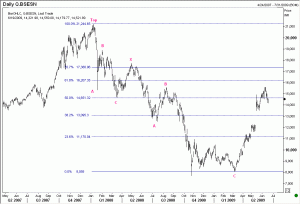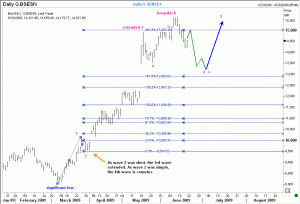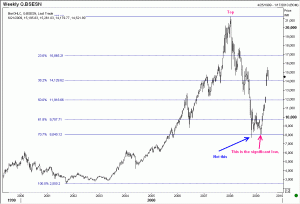Is there one right way to count the waves? I can say this for sure. Until a move is over, there is certainly more than one way to count. Sometimes, even after a move is over, one has to decide where exactly the move finished. Take the case of India’s Sensex. Many Elliott wave analysts would say that the move finished at 7,697 on 27 Oct. After all, didn’t we get a sharp rally from there to 10,945?  But it is perfectly possible to argue that that low was only the end of a huge 3rd wave, and the real end of the move happened on 6th March at 8,047. I am going to take the latter approach, at least for now. I have two main reasons for this, and the first two charts to illustrate why I prefer to call 8,047 as the real low.
But it is perfectly possible to argue that that low was only the end of a huge 3rd wave, and the real end of the move happened on 6th March at 8,047. I am going to take the latter approach, at least for now. I have two main reasons for this, and the first two charts to illustrate why I prefer to call 8,047 as the real low.
Having decided that we should start counting the new waves from 8,047, one should decide how to label the rally that reached 15,600. This is also illustrated in the 3rd chart that you see here. As you can see, I am making a whole bunch of assumptions, and anything can go wrong. However, you get a feel of the challenges that a wave analyst faces when deciding where the market will go next. It is perhaps these arbitrary labelling that causes many traders to dismiss wave analysis as utterly useless. However, my contention is even if we get the labels wrong, we will probably be right in the direction of the next move, and that itself is worth the effort.


